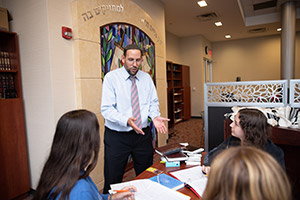Talmud
 Talmud shiurim at Frisch focus on the textual analysis of sugyot, while using the text as a springboard to analyze global concepts in Shas. Each sugya is dissected to gain a working understanding of the Talmud and its commentaries. Students explore disputes of the tannaim, ammoraim, rishonim and achronim to discern not only the substance of the argument but the rationale behind differing views. Sugyot are followed to their halachic conclusions in order to clearly demonstrate the process which culminates in normative halachic practices. Students learn to think critically about the text and ask questions when confronting a sugya. Talmud teachers develop and utilize an array of pedagogic methodologies, including the creative use of technology. The Talmud faculty aims to instill within its students a love of Torah she-ba’al peh and an appreciation for its beauty and complexity, as they become the next link in the chain of the mesorah.
Talmud shiurim at Frisch focus on the textual analysis of sugyot, while using the text as a springboard to analyze global concepts in Shas. Each sugya is dissected to gain a working understanding of the Talmud and its commentaries. Students explore disputes of the tannaim, ammoraim, rishonim and achronim to discern not only the substance of the argument but the rationale behind differing views. Sugyot are followed to their halachic conclusions in order to clearly demonstrate the process which culminates in normative halachic practices. Students learn to think critically about the text and ask questions when confronting a sugya. Talmud teachers develop and utilize an array of pedagogic methodologies, including the creative use of technology. The Talmud faculty aims to instill within its students a love of Torah she-ba’al peh and an appreciation for its beauty and complexity, as they become the next link in the chain of the mesorah.
Beit Midrash Track
In the Beit Midrash Track, students build a wide array of skills necessary to excel in learning Gemara. Sugyas are chosen based on student interests, as students analyze the texts in chavruta or small groups. The goals of the Beit Midrash Track are twofold: 1) to learn Bekiut: to finish a masechta, to learn how to comfortably move through the shakla v’tarya (give and take) of the Gemara and gain proficiency in reading and understanding Gemara with Rashi’s Commentary. 2) to learn B’iyun: to engage in a deep analysis of the Gemara and Rishonin, to become familiar with the commentaries in the back of the Gemara and when and how they are used, and to delve into classic Shas sugyot and concepts. Upon completion of the Beit Midrash Track, students should develop the capability of learning an entire sugya on their own, which includes: reading the Gemara, identifying the fundamental questions and concepts that arise in the text, and understanding how to find answers through the Rishonim and Achronim, both those that deal with the “lomdus” and those that deal with the halacha. The Beit Midrash Track is intended for self- motivated students who desire to engage in rigorous Talmudic study beyond the requirements of the formal Gemara curriculum.
Senior Electives
The World of Torts: Studies in Bava Kamma (Honors) Bava Kamma deals with the Torah’s approach to personal liability and property damage. The nuances of Talmudic principles presented in Bava Kamma are analyzed in chavruta preparation sessions, shiur b’iyyun, as well as in an independent learning bekiyut project. Principles are then applied to a myriad modern day scenarios encountered by pet owners, motorists, construction workers among others. The role of money and financial responsibilities in society is examined from a Torah perspective.
Masechet Shabbat: The Evolution of Halacha From Conception to Practice (Honors)
Students study many of the positive commandments of Shabbat. The 39 prohibited melachot are also analyzed, tracing them back to their biblical sources and following the development of their interpretation in the Talmud and later commentaries, in an effort to arrive at a stronger understanding of our contemporary Shabbat observance. Finally, students examine fundamental concepts which underlie the laws of Shabbat.
Mastering a Masechet: Masechet Ta’anit From Beginning to End (Honors)
Students learn an entire masechet of Shas in a bekiyut style and improve their analytical skills through both the halachic and aggadic sections of Talmud.
Celebration and Renewal
Important and relevant topics of daily Jewish life and life cycles are covered in this course, including weddings and mourning, as well as the practice and sanctity of holidays. While the focus of the shiur is conceptual, there is an integral textual component which traces how the sugya develops from the Gemara to the rishonim through to modern poskim and commentators.
The Brisker Method: A Conceptual Approach to Major Topics in Shas (Honors)
Students are introduced to “lumdus” and the methodology of categorizing and arriving at precise definitions of Talmudic concepts which can then be applied across the broad spectrum of Shas. The interpretations of the rishonim and achronim are also used to help students stregthen their analytical skills.
The Sanctity of Family
In Masechet Kiddushin, students analyze the halachic process of getting married, as well as many mitzvot that arise in the family context, such as children honoring their parents, parents educating their children in Torah and the mitzvah of honoring elders and teachers. Additionally, Masechet Kiddushin raises important questions of Jewish thought, including whether it is better to learn Torah or perform mitzvot, and whether there is reward for mitzvot in this world or only in the next. Attention is devoted to improving textual and analytical skills in an effort to enable students to continue their Gemara study beyond their high school years.
Masechet Shabbat: The Evolution of Halacha From Conception to Practice
Students learn major concepts discussed in Masechet Shabbat necessary in order to understand the modern day application of the laws of Shabbat. In addition to discussing the 39 melachot from both a legal and philosophical perspective, attention will also be devoted to the positive mitzvot of Shabbat and modern halachic scenarios.
Holidays in the Talmud
Students delve into seasonally appropriate Talmudic texts dealing with the holidays that correspond to that time of year. Topics covered provide practical and theological insight into the upcoming holidays, as students prepare divrei Torah for each occasion.
Mastering a Masechet: Masechet Megillah From Beginning to End
Students study the topic of Purim in Masechet Megillah in bekiyut style. Each class focuses on the shakla v’tarya (give and take) of Talmudic discourse. Since Masechet Megillah contains large sections of aggadata, students gain exposure to this often neglected type of Talmudic literature, rich in descriptive moral teachings.
Development of Halacha
Students explore a wide variety of halachic topics such as tefillah, brachot, tefillin, Shabbat and chaggim from a variety of different Masechtot, with a focus on practical halacha. The law is traced from the Talmud to major rishonim, emphasizing its application in the Shulchan Aruch.
Crime and Punishment: Masechet Makkot
Using Masechet Makkot as a template, students develop the skillset to engage with any text of the Talmud. Masechet Makkot deals with the system of governmental laws that establishes and preserves order and describes various situations in which punishments apply and how they are administered. Accidental murder, the laws of flogging and plotting witnesses are among the various topics examined.






 Talmud shiurim at Frisch focus on the textual analysis of sugyot, while using the text as a springboard to analyze global concepts in Shas. Each sugya is dissected to gain a working understanding of the Talmud and its commentaries. Students explore disputes of the tannaim, ammoraim, rishonim and achronim to discern not only the substance of the argument but the rationale behind differing views. Sugyot are followed to their halachic conclusions in order to clearly demonstrate the process which culminates in normative halachic practices. Students learn to think critically about the text and ask questions when confronting a sugya. Talmud teachers develop and utilize an array of pedagogic methodologies, including the creative use of technology. The Talmud faculty aims to instill within its students a love of Torah she-ba’al peh and an appreciation for its beauty and complexity, as they become the next link in the chain of the mesorah.
Talmud shiurim at Frisch focus on the textual analysis of sugyot, while using the text as a springboard to analyze global concepts in Shas. Each sugya is dissected to gain a working understanding of the Talmud and its commentaries. Students explore disputes of the tannaim, ammoraim, rishonim and achronim to discern not only the substance of the argument but the rationale behind differing views. Sugyot are followed to their halachic conclusions in order to clearly demonstrate the process which culminates in normative halachic practices. Students learn to think critically about the text and ask questions when confronting a sugya. Talmud teachers develop and utilize an array of pedagogic methodologies, including the creative use of technology. The Talmud faculty aims to instill within its students a love of Torah she-ba’al peh and an appreciation for its beauty and complexity, as they become the next link in the chain of the mesorah.